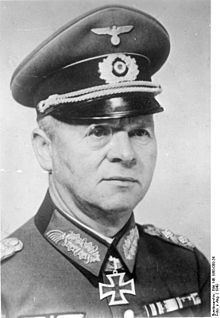Years of service 1906–42 Name Georg Stumme | Service/branch German Army | |
 | ||
Born 29 July 1886Halberstadt ( 1886-07-29 ) Commands held 1st (Preus.) Reiterregiment2nd leichte Division7th Panzer DivisionXXXX.ArmeekorpsPanzer Army Africa Battles/wars World War IWorld War II Similar People Wilhelm Ritter von Thoma, Bernard Montgomery - 1st Visco, Erwin Rommel, Ettore Bastico, Claude Auchinleck | ||
Georg Stumme (29 July 1886 – 24 October 1942) was a general in the Wehrmacht of Nazi Germany during World War II who briefly commanded of the Axis forces at the beginning of the Second Battle of El Alamein. He took part in the Battle of France, the invasion of Yugoslavia and the invasion of the Soviet Union, Operation Barbarossa. He was a recipient of the Knight's Cross of the Iron Cross, the highest award in the military and paramilitary forces of Nazi Germany during World War II.
Contents
World War II
Stumme fought in World War I and then became part of the General Staff. After the Nazis came to power in 1933 he was promoted to Oberst (1933) and Generalmajor (1936). Stumme rose to become commander of 2nd Light Division, which was formed on 10 November 1938.
Stumme had achieved the rank of Generalleutnant by the beginning of the war, and he commanded the 2nd Light Division in the attack on Poland in 1939. After the unit was converted into the 7th Panzer Division on 18 October 1939, he relinquished command of the 7th Panzer Division to Erwin Rommel in 1940, and was appointed as commander of XXXX. Armeekorps on 15 February 1940, which became XXXX Corps (motorized) in September 1940. He led this corps in the 1940 Ardennes campaign, being promoted to General der Kavallerie on 1 June 1940. Shortly thereafter he was awarded the Knight's Cross of the Iron Cross for bravery during the Battle of France.
Stumme was sent to Bulgaria and participated in the attacks on Yugoslavia and Greece. Stumme led the attack of the right wing of Wilhelm List's 12th Army. His two divisions drove west separately into Yugoslavia and then wheeled south meeting each other at Monastir on 9 April. He then participated in the invasion of Greece. He was promoted to General der Panzertruppe.
In Operation Barbarossa Stumme served under Field Marshal Fedor von Bock. Stumme and his men succeeded in capturing Mozhaisk. He then participated in Fall Blau to lead the advance of Paulus' 6th Army with his redesignated XXXX. Panzerkorps.
In June 1942 some German plans were captured by Soviet forces. Hitler blamed Stumme and ordered that he be court-martialed. He was relieved of command on 21 July 1942, was found guilty and was sentenced to five years imprisonment, but Bock secured his release. Ulrich von Hassell called it a case of "the grotesque game of tin soldiers which Hitler plays with the generals in his diary", and commented: "Stumme, commanding general of a tank corps, was sentenced to five years' imprisonment because [of the actions of a divisional staff officer]. He was immediately pardoned, with Göring promising him a new command, and is now being sent to Africa as a substitute for Rommel. An unmilitary, un-Prussian farce".
Stumme joined the Afrika Korps in Egypt in September 1942, which was confronting the British at El Alamein. Erwin Rommel had been relieved due to illness and exhaustion. Stumme arrived on 19 September to be briefed a few days before Rommel departed. He took overall command of Panzer Army Africa (combined German and Italian forces), with Ritter von Thoma replacing the wounded Walther Nehring as commander of the Africa Korps.
Battle of El Alamein
Stumme "faithfully followed the plan left by Rommel" for responding to the expected attack. His letters to his superiors indicate he was not optimistic, and agreed with Rommel that the only real prospect of success lay in keeping the enemy wrongfooted with attacks, for which he did not have the resources. Just over a month after his arrival the British began their attack on 23 October with a massive bombardment. Stumme prohibited the use of German artillery ammunition to attack the British forward assembly areas, where the troops were vulnerable, preferring to keep his limited resources in reserve. This has been described by Reinhard Stumpf as "a grave mistake that enabled the British to form up for the attack in relative peace".
Unlike Rommel, Stumme travelled without the protection of an escort and radio car. On 24 October Stumme and Colonel Andreas Büchting, his chief signals officer, drove to the front to review the situation. On the way to the command post, the car came into open view and was attacked. Büchting was killed by a shot in the head. Stumme jumped out of the car and apparently was holding onto the side while the driver drove out of range. He was found dead along the track the next day, with no wound that could be seen. He was known to have high blood pressure and it was thought he had died of a heart attack. He was replaced as commander of Panzer Army Africa with the return of Erwin Rommel, while the Afrika Korps was commanded by General der Panzertruppe Wilhelm Ritter von Thoma.
Assessments
Stumme has been described as a "competent but pleasure-loving general", who cultivated a convivial relationship with his officers, unlike the hard-driving Rommel. One of his officers, Friedrich von Stauffenberg, said that Stumme created a "congenial" atmosphere while maintaining a "crack, well-officered division". According to Mark M. Boatner,
The short, good-humored Stumme suffered from chronic high blood pressure that gave his face a permanent flush. The troops called him "Fireball," and the monocled little general, although old for front line duty even by Wehrmacht standards, had a flair for seizing tactical opportunities.
Rommel had suggested that Heinz Guderian should replace him in North Africa, but Guderian was not in favor at the time and his request was refused. Stumme was given the command instead, and Rommel had confidence in him as a commander.
